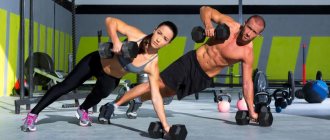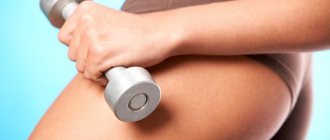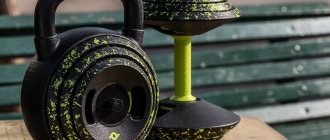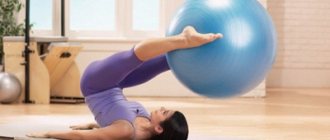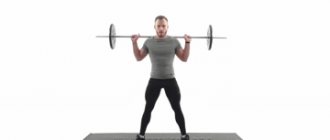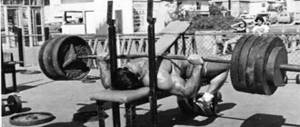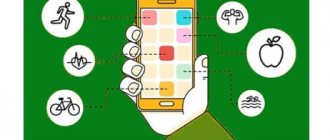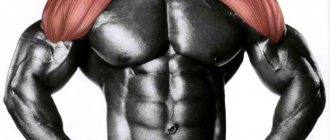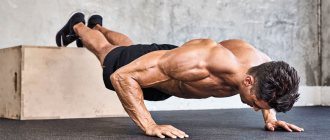Hello friends. We continue to provide you with useful and necessary information. Today we will look at the best exercises for training the pecs and triceps. This article is just a text version of the video. The video itself is located at the bottom of the page. Those who cannot or do not want to skip a significant amount of text can simply turn on the video. And those comrades who want to read - well, welcome.
This series of articles examines the use of muscle bundles in various exercises. And the links are not to subjective data. The basis is specific research. This study was conducted 7-8 years ago by Bret Contreras, a very famous American trainer. He became interested in which exercises used which muscles worked more. In particular, breasts. We have dumbbell presses, barbell presses, different angles, we have dumbbell flyes, machine flyes. There are a huge number of exercises, and you need to determine which of these exercises work better and which ones work worse.
And so Contreras conducted a corresponding study using electrical myostimulation. What is electromyostimulation? This is when sensitive sensors are attached to all the bundles, which measure electrical activity during contraction. That is, the more the muscle contracts, the greater the activity. That is, using this indicator you can find out in which exercises a particular muscle works more, and in which exercises it works less. For a better understanding, it is worth reading the previous article in this series, which discussed exercises for the shoulders and upper trapezius. Today we’ll talk about the most effective exercises for training the pectorals and triceps.
Why pecs and triceps? Because traditionally, when training chests, the entire pushing group is used. That is, a bench press group. We have pulling exercises where we bring ourselves closer. There are pushing exercises, when we push the projectile away from ourselves. So, when we train the chest, and it is a classic pressing muscle group, in many exercises, at least in the pressing ones, in addition to the chest, the triceps always work. That is, the triceps is a muscle that almost always works in conjunction with the chest, if we are talking about some basic exercises such as barbell and dumbbell presses with different grips. Therefore, it will be interesting to figure out which exercises are best for the pecs and which for the triceps. And among them there was some specific rank so that we could highlight which exercises work best on the top of the chest, the middle of the chest and the bottom of the chest.
Go.
| EXERCISE | Upper chest | Mid chest | Bottom of chest | Long head of triceps |
| Light bench press | 125.0 230.0 | 181.0 408.0 | 116.0 347.0 | 47.8 109.0 |
| Heavy bench press | 109.0 198.0 | 177.0 288.0 | 130.0 345.0 | 73.5 153.0 |
| Positive Incline Bench Press | 130.0 261.0 | 156.0 422.0 | 89.4 337.0 | 55.8 109.0 |
| Dumbbell bench press | 122.0 192.0 | 204.0 451.0 | 88.1 252.0 | 43.7 128.0 |
| Positive Incline Dumbbell Bench Press | 128.0 310.0 | 124.0 286.0 | 59.0 172.0 | 35.5 98.9 |
| Dips (no weight) | 73.7 164.0 | 105.0 234.0 | 124.0 266.0 | 73.9 150.0 |
| Dips (with weight) | 140.0 232.0 | 192.0 332.0 | 214.0 418.0 | 124.0 217.0 |
| Close grip barbell press | 106.0 211.0 | 137.0 229.0 | 77.5 217.0 | 52.6 107.0 |
| Guillotine barbell press | 114.0 302.0 | 176.0 511.0 | 169.0 502.0 | 61.9 142.0 |
| Bench press | 132.0 265.0 | 197.0 356.0 | 154.0 347.0 | 64.8 170.0 |
| Dumbbell flyes lying on a horizontal bench | 133.0 231.0 | 195.0 493.0 | 160.0 450.0 | 14.9 31.3 |
| Dumbbell flyes lying down with a positive incline | 125.0 249.0 | 135.0 344.0 | 77.3 257.0 | 12.6 20.0 |
| Bringing your arms in front of you in a crossover with high rollers | 107.0 201.0 | 168.0 311.0 | 153.0 397.0 | 9.6 19.1 |
| Bringing your arms in front of you in a crossover with medium rollers | 154.0 252.0 | 154.0 271.0 | 124.0 251.0 | 11.5 23.1 |
| Bringing your arms in front of you in a crossover from the lower rollers | 135.0 233.0 | 78.6 249.0 | 36.9 74.8 | 20.2 77.2 |
| Push-ups without weight | 109.0 204.0 | 124.0 252.0 | 101.0 194.0 | 24.0 38.7 |
| Close grip push-ups | 103.0 188.0 | 118.0 188.0 | 70.7 119.0 | 22.9 43.2 |
| Bench push-ups | 96.6 156.0 | 102.0 232.0 | 52.7 167.0 | 24.0 46.6 |
| TRX hanging push-ups | 113.0 206.0 | 166.0 363.0 | 177.0 352.0 | 35.3 107.0 |
| Pullover lying on a bench | 55.7 119.0 | 88.6 186.0 | 53.8 164.0 | 66.9 153.0 |
| Handlebar Press in Block Frame | 143.0 272.0 | 45.7 91.0 | 53.0 127.0 | 21.0 52.6 |
| French bench press | 45.6 89.5 | 21.5 48.6 | 70.7 118.0 | 116.0 172.0 |
| Extension on a pulley with a rope handle | 6.9 14.9 | 5.4 21.9 | 36.1 82.5 | 135.0 276.0 |
| Extension on a block (straight handle) | 9.3 21.3 | 9.3 18.7 | 78.2 172.0 | 132.0 255.0 |
| Extensions from behind the head on a block | 19.4 41.0 | 19.2 130.0 | 40.6 126.0 | 109.0 206.0 |
Upper chest exercises
Number one, the best exercise available for training your upper pecs is the positive incline dumbbell bench press. There is simply no better exercise than this one in terms of engaging your pecs. No dumbbell flyes, no incline bench presses - it will all be much worse. Remember, if we talk about an ideal situation, experience has shown that the first place for the upper chest is the dumbbell bench press with a positive incline.
Second place goes to a specific exercise called the Guillotine. You can google, look, study. This is truly the best exercise. Why? Firstly, because it is very effective for the upper pectoral muscles. The difference between the Guillotine and the overhead dumbbell press is very slight. These exercises practically go side by side. Even though the guillotine is performed on a horizontal bench. But due to this specific technique, when you lower the bar of the barbell not on your nipples, but on your throat (that’s why the name is), and due to this technique, all three parts of your pecs are involved. That is, the middle part, the lower and even the upper part work very actively. And if in the middle and lower parts this exercise is almost the most effective of all possible, then speaking about the upper part for our pecs, this exercise is slightly inferior to the dumbbell bench press.
The third place is also occupied by the barbell press. But somewhat specific: bench press lying on the floor. This exercise is very rarely done. The only people who do this exercise more or less regularly are, as a rule, wrestlers and representatives of mixed martial arts. Because this type of press allows you to work with large weights in a partial amplitude. And it has great functionality. Let's say when you are fighting, you can push someone aside, lean back. This is a very functional movement. And it trains very well when you lie on the floor and press not on the bench, but on the floor. This exercise is much more effective than a regular horizontal barbell bench press. Despite the fact that the amplitude is shorter. Why? Because when you bench press, you tend to bridge to some degree. Because your feet are on the floor and your spine is on the bench. Accordingly, there is some certain deflection. To avoid this deflection, you need to raise your legs on the bench - then you won’t be able to cheat, then your chest will work more isolated.
Let's say, a bodybuilding scheme for performing all barbell presses is without cheating and without bridges. To make it harder for your pectoral muscles to work. All other sports try to make it easier for their muscles to work because they need functionality, not size. The technique is simple. You lay down on the floor, adjust the racks - and take it and start working. True, you need to reconfigure a little, because it’s unusual. You have to work in partial amplitude. At the bottom point, your elbows rest on the floor, and you cannot lower them all the way. But on the other hand, it gives a certain comfort, a certain feeling of security. You can do this on your own, without a partner. And don’t be afraid that you will be crushed. When you lie on the floor, you have a gap between the bar and the floor, you won't be crushed in any way. In this regard, it is more calm and safe. And the trick: in this exercise, despite the fact that we are talking about the bench press on the floor, the horizontal press, we are now discussing the rating of the best exercises for the upper chest segment, strange as it may seem. So, the horizontal bench press on the floor engages this part of the pecs very well, unlike a regular bench press.
The fourth place is a crossover with medium rollers. Block frame, middle rollers. There are three roller positions in the block frame. You can work on the chest with high rollers, with medium rollers, or with low rollers. It is believed that when you work from the lower rollers, your upper chest works more, when you work from the upper rollers, your lower chest works more, and when you work on the middle rollers, it seems like the middle part of your chest works. In fact, this is not entirely true. Let's say for the lower chest - to some extent, yes, but this is not the most effective exercise. As for the top of the chest from the lower rollers, this does not work at all. Remember: the most effective position that works the most on your chest, midsection, and upper body is when the rollers are level with your chin or your nose. Middle position. With this position, among other things, the exercise ranks fourth in the ranking of the best exercises for the upper part of your chest.
And fifth place is shared by exercises such as dumbbell flyes lying on an incline bench with a positive incline and the barbell bench press lying on an incline bench with a positive incline. These traditional exercises, which are considered almost the best, are in fact not the best. And if you choose something most effective for the upper chest, then in this regard the dumbbell bench press with a positive incline takes first place. That is, here is our ranking for the upper pecs. And we move on to the middle part.
Exercises for the middle part of the pectorals
The most effective exercise for training your midsection is the guillotine style bench press. In general, this is a unique exercise. This is the best exercise for all three sections of your pectoral muscle. This is generally the best exercise for training your chest in terms of engaging the intensity of your muscle fibers. There is nothing better. The main thing is not to chase the scales, learn the technique. Because at the bottom point there is a very strong stretch. When you lower the barbell onto your throat, there is a very strong tension. Sometimes you can avoid touching your throat with the bar. The middle and top portions tend to lag more often. The lower part of the pecs is usually fine in everyone. But there are questions with the middle and top.
Second place goes to dumbbell flyes lying on a horizontal bench. A fairly well-known and simple exercise in which the elbow joint does not move, and movement occurs only due to movement in the shoulder joint. Due to this, isolated work with the chest occurs. And given that there is no tilt, the middle part of the pecs works more.
The third place is also occupied by a horizontal bench. Dumbbell bench press on a horizontal bench.
The fourth most effective exercise is the bench press with a positive incline. Traditionally, people think that this exercise is for training the upper pecs, but this is not entirely true. There is information about this, if anyone is interested, you can google it. A slight incline is not an attempt to shift the load to the upper pecs. The slight upward tilt is an attempt to give your pecs a more even load so that your midsection works more evenly. And we move on to the lower part of the pectoral muscles.
Triceps
Close grip bench press 4 sets of 8-12 reps
French bench press 4 sets of 8-12 reps
Triceps on the block 3-4 sets of 10-15 reps
After completing exercises for the pectoral muscles, rest for 4-5 minutes, then begin training the triceps. While resting, try not to let your muscles cool down. You don’t need to sit on a bench like a grandfather on a pile. Walk around and do breathing exercises. Massage your triceps and forearms.
Training chest and triceps on the same day is a better option than training these muscle groups on different days. If in your split these muscle groups are trained on different days, it is necessary that there be a gap of at least two days between these workouts.
When you pump up your pectoral muscles, and the next day you train your triceps, the triceps, tired from training your pectoral muscles, will not be able to perform work with the required weights. The result is a drop in working weights and poor quality training.
Exercises for the lower pectoral muscles
There will be a few surprises here. The fact is that the first two exercises are identical to the most effective exercises for the middle part of the pectorals. That is why, as a rule, the lower part is almost always overdeveloped, while the middle and upper parts are almost always lagging behind. Because in so many exercises the load is taken by the lower sections.
The first most effective exercise for training the lower part of your pecs is the guillotine style bench press. The same exercise that Vince Gironda invented, and which, in general, is quite well known abroad. But for some reason no one ever does it here. Try it in your chest workouts - you will find a lot of pleasant surprises. And the pumping sensations are different. and there will be pain.
Second place goes to dumbbell flyes lying on a horizontal bench. The same exercises as for the middle of the pecs.
The third place is occupied by such an exercise as push-ups on uneven bars with weights. Please note: it is very important that this be done with weight. Not only because the load changes. The fact is that when you do push-ups with a weight, the vector itself also changes. You hold a slightly more upright position. And when you do push-ups without weight, you lean forward very much. In order to shift the load to the lower parts of the pectorals, you need to maintain a more vertical position. And weight helps in this regard. That is, you have placed some weight on your belt, and your position has become more favorable for engaging the lower part of your pectoral muscles.
A lot depends on the goal here. Maybe you're not using this exercise to emphasize your lower pecs. Although it is recommended, because in this position both the triceps work well and the pecs work well.
The fourth exercise closes our chart. Block frame, top rollers. Bringing your hands together in a crossover from the top rollers. When we pull from top to bottom, this load is mainly carried out by the lower parts of our chest. There are a lot of exercises. The table contains these exercises and numbers - you can see which is more effective and which is less effective. Now we are talking about the most effective ones. The fact that dumbbell flyes are in second place for the lower pecs does not mean that this exercise is so-so, you only need to do the guillotine. All four of these exercises that are listed are the cream of the crop, the elite. Any of them can be taken to train your pectoral muscles.
And we still have triceps. Go.
Triceps exercises
In general, Contreras did not test the entire triceps. Everyone knows that the triceps consists of three heads. But Contreras tested the long head, tested how it worked in a variety of exercises to understand which ones were best to use for training the long head. And there are surprises here too. There is such a traditional point of view in bodybuilding. In order to work the long head of the triceps, the exercises must be done in a stretched position from behind the head. All these extensions and French presses are considered to involve the long head of the triceps more. And from the point of view of pumping, in theory, it would be necessary to use just such exercises. But the experiment showed that this is not so. The experiment showed amazing things.
The first place, the most effective of all possible options for training the long head of your triceps, is the cable pulley extension. The peculiarity of this exercise is that it is not just straightening down at the elbow joint, but you also need to turn your arms a little at the lowest point. The palm pronates, and due to this pronation, you additionally activate the triceps. This is the best, most effective exercise for training the long head of the triceps.
The second exercise is almost the same. But we are already using a straight handle. That is, arm extensions on the upper block with a straight handle. This exercise takes an honorable second place.
The third place is occupied by such an exercise as push-ups on uneven bars with weights. It is good for both the pecs and for training the long head of the triceps.
And only fourth place is occupied by extension from behind the head on the upper block. Or with dumbbells. If we talk about such a traditional exercise as the French bench press, then it occupies only fifth place in the ranking. That is, this is not the most effective exercise. And many intuitively feel this. Extension on a block works better and is more effective for the long head of the triceps.
These are the revelations.
How to train triceps at home: Triceps pumping exercises at home
Lack of opportunity or desire to go to the gym should not become an obstacle to training. Moreover, you can always use, for example, water bottles as weights, and a bench in some exercises can be replaced by the floor or a regular chair.
French bench press with weights
An excellent isolated load on the triceps will be given by the French dumbbell bench press. You can perform the exercise not only with a barbell, but also with dumbbells. At home, you can lie on the floor (on a rug). If you don't have dumbbells on hand, plastic bottles filled with water or sand will do. If you have not done this exercise before, use light weights, as the French press puts more stress on the elbow joint. The exercise is basic and good for pumping up your triceps.
Technique:
- Take a horizontal position, take weights in your hands.
- Raise the dumbbells above you. Straight arms are tilted towards the head at a slight angle.
- As you inhale, bend your elbows, bringing the dumbbells to approximately ear level. The shoulders remain motionless.
- As you exhale, extend your arms to the starting position, straightening them completely. Make sure your shoulders are secure. Do not spread your arms; the distance between the dumbbells in the starting position should be 20–25 centimeters.
- Do 10-12 reps in 2-3 sets.
The further your arms move behind your head, the greater the load.
Video: Triceps pumping: French dumbbell bench press, nuances of execution
Reverse push-ups
To perform reverse push-ups at home, you can use a chair or any low furniture that you can lean on. The lower the support, the more load the triceps will receive. This is a basic exercise and you can vary the load. Beginners and women will make the exercise easier for themselves by helping with the process with their feet. Trained athletes can perform reverse push-ups and further increase their weight with the help of a heavy backpack.
The technique is shown in the photo below:
- Find something high, such as a chair. Turn your back to him and lower yourself down, resting your hands on the chair slightly wider than shoulder-width apart.
- Feet firmly on the floor. Straight legs will provide more load than bent knees.
- Inhale and slowly lower yourself down, bending your elbows. Calculate your strength; you don’t need to sink all the way to the floor if you feel that you won’t be able to get up later.
- As you exhale, rise up by straightening your arms.
- If your goal is the fastest possible muscle growth, then the negative phase of the exercise should take 2-3 times longer than the positive phase. That is, you need to go down slower than you go up.
- Do 8-12 reps in 2-3 sets.
Bent legs make it easier to perform.
If you have shoulder problems, perform reverse push-ups only with your doctor's approval.
Video: Reverse push-ups from a bench, different difficulty options
Seated one-arm dumbbell French press
The good thing about this exercise is that it can be performed by people of any skill level. You can start doing it with the smallest weights of 1–2 kg. This type of bench press is ideal for doing at home; it does not require much space, and almost any household item that is convenient to hold with one hand can serve as a weight.
Technique:
- Sit up straight, place your feet on the floor shoulder-width apart, the position should be stable.
- Take the weight in one hand and lift it above your head, perpendicular to the floor.
- The position of the working hand is correct when the palm faces forward and the little finger faces the ceiling. The elbow should not be turned either forward or backward.
- As you inhale, bend your working arm at the elbow and smoothly lower the dumbbell behind your head until your forearm touches your biceps.
- As you exhale, straighten your arm and return the dumbbell to the top, it is very important that the shoulder does not move. If you can't lock your shoulders, use a lighter weight.
- Do 10-15 reps in 2-3 sets.
1
Video: One-arm French dumbbell press in a seated position
Bent over arm extension with dumbbell
This exercise works the triceps in isolation without damaging your shoulders or back. Bent-over arm extensions are suitable for beginners and can be used to begin preparing for the transition to more demanding exercises.
Technique:
- Take a suitable weight in your working hand. To support your feet, you can use a chair, leaning on it with one knee, or you can simply stand on the floor, for stability, pushing forward the leg opposite your working hand.
- If using a chair, use your non-working hand to grasp the edge of the chair for balance. Place your knee on the chair. If you work without a chair, bend your knees slightly.
- Tilt your straight body forward until it is diagonal with the floor. The stronger the slope, the greater the load will be.
- Raise your working arm to the starting position: the shoulder is parallel to the body, the elbow joint is bent at a right angle.
- As you exhale, gently lift the dumbbell, straightening your arm at the elbow until it is straight.
- As you inhale, bend your arm and return it to its original position.
- Do 8-12 reps in 2-3 sets for each arm.
The shoulder is fixed, the arm moves in an arc.
Video: How to properly perform bent over dumbbell extensions
Close grip push-ups
Technique:
- Take a lying position, the weight should fall on straight arms and toes. Hands should be at a distance narrower than shoulder width, legs and body should form a single straight line.
- The palms can be turned with the fingers towards each other at an angle of no more than 30 degrees.
- Bend your elbows and inhale as you lower yourself down. Don't lie on the floor, keep tension in your arms.
- As you exhale, straighten your arms and rise up.
- Perform 10–15 reps in 2–3 sets.
1
Beginners can change the emphasis by standing on their knees rather than on their feet, and advanced athletes can make push-ups more challenging by wearing a weighted backpack.
